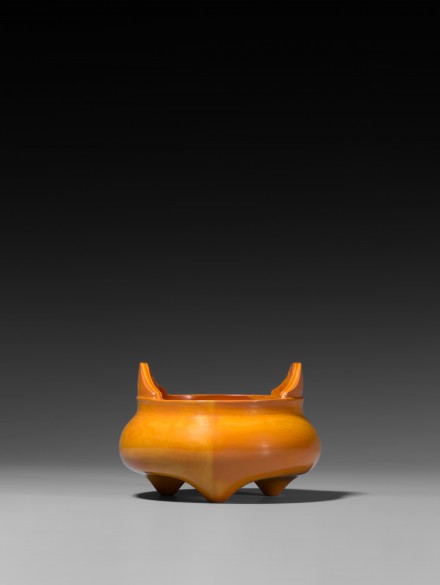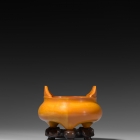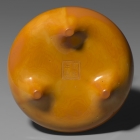J.J. Lally & Co., Oriental Art / New York City, New York
MenuPast Exhibition
ELEGANTLY MADE: Art for the Chinese Literati
March 13-27, 2020

19.
AN IMPERIAL REALGAR-IMITATION GLASS TRIPOD CENSER
Mark and Period of Qianlong (1736-1795)
of shallow circular form, following a bronze prototype, carved from bright orange glass suffused with more intense reddish areas, imitating the ‘magic’ mineral realgar, the highly polished rounded sides rising to a wide mouth with slightly flared rim surmounted by a pair of upright loop handles and resting on three short tapered feet, incised at the center of the base with a four character mark of Qianlong within a square frame, together with a wood stand carved as a mallow flower.
Diameter 4 1⁄4 inches (10.5 cm)
Provenance
From the Collection of Nathan Benz, California
Christie’s New York, Fine Chinese Ceramics and Works of Art, 30 March 2005, lot 193
J. J. Lally & Co., New York
Shuisongshi Shanfang Collection
Realgar (雄黃, xiong huang) is a naturally occurring sulphide of arsenic which, although highly toxic, has a long history of use by Daoist alchemists in China as an ingredient in elixirs of immortality. Several Chinese emperors, beginning with Qin Shi Huang (d. 210 B.C.) and including Yongzheng (r. 1722-1735) are recorded in Chinese history as having died from taking elixirs containing realgar and other ‘magic’ ingredients in pursuit of longevity.
Recent research indicates that realgar-imitation glass may be one of the earliest types of glass made in the Beijing palace glassworks for the exclusive use of the imperial court from the early years of the 18th century.
A Qianlong period realgar-imitation glass censer from the collection of Professor and Mrs. Peter H. Plesch is illustrated by Curtis, ‘Glass from China for the Land above the Clouds,’ Journal of Glass Studies, Vol. 46, New York, 2004, p. 152, fig. 6 and the same censer is illustrated again by Curtis, Glass Exchange between Europe and China, 1550-1800: Diplomatic, Mercantile and Technological Interactions, Farnham, England, 2009, p. 76, fig. 6.3.
Realgar-imitation Qianlong period glass vessels in a variety of different shapes are recorded in museum and private collections, including a mallet shape vase published by Zhang (ed.), Guang ning qiu shui: Qing gong Zaobanchu boli qi (Luster of Autumn Water: Glass of the Qing Imperial Workshop), Beijing, 2005, p. 156, no. 25; and a hexafoil pouch shape vase from the Sloane Collection exhibited at the Royal Academy of Arts and published by Rawski and Rawson (eds.), China: The Three Emperors, 1662-1795, London, 2005, p. 304, no. 234.
Compare also the Qianlong mark and period yellow glass censer of very similar form published in the catalogue of the thirty-fifth anniversary exhibition of the Min Chiu Society, In Pursuit of Antiquities, Hong Kong, 1995, p. 237, no. 207.
清乾隆 御製仿雄黃料沖耳乳足爐 徑 10.5 厘米
「乾隆年製」雙方框款
來源 加州 Nathan Benz 藏
紐約佳士得 2005 年 3 月 30 日,拍品第 193 號
紐約藍理捷中國文物
水松石山房藏
Additional Images (Touch to enlarge)
19.
AN IMPERIAL REALGAR-IMITATION GLASS TRIPOD CENSER
Mark and Period of Qianlong (1736-1795)
Diameter 4 1⁄4 inches (10.5 cm)

